tornado outbreak
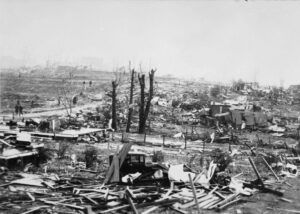 Tornadoes are a common storm in some parts of the United States. The most common area for them is called Tornado Alley. Usually, when storms go through, you might hear of tornado watches. That doesn’t mean that there are multiple tornadoes in an area, but it could. In 1936, beginning on April 5th and extending through April 6th, the states of Mississippi and Georgia found themselves in the middle of a tornado outbreak, which is several tornadoes in an area, of course. This is the only continuous tornado outbreak in United States history to produce more than one tornado with triple digit death tolls. Also, severe flash floods from the associated storms caused millions of dollars in damage across the region.
Tornadoes are a common storm in some parts of the United States. The most common area for them is called Tornado Alley. Usually, when storms go through, you might hear of tornado watches. That doesn’t mean that there are multiple tornadoes in an area, but it could. In 1936, beginning on April 5th and extending through April 6th, the states of Mississippi and Georgia found themselves in the middle of a tornado outbreak, which is several tornadoes in an area, of course. This is the only continuous tornado outbreak in United States history to produce more than one tornado with triple digit death tolls. Also, severe flash floods from the associated storms caused millions of dollars in damage across the region.
The storm, called the Tupelo-Gainesville Outbreak, produced at least 12 tornadoes. The outbreak took place over two days, April 5th and 6th, but was really just about 12 hours in duration. The storm hit Tupelo, Mississippi at 8:30pm on April 5, 1936. It was the fourth-deadliest tornado in United States history. The storm came out of a group of storm cells, and first touched down in a rural area about eight miles from the city. The twister killed a family of 13, sweeping their house away as the tornado made its way toward Tupelo. Many more were injured before it even reached the city. The tornado was retroactively rated an F5 on the Fujita scale, it caused total destruction along its path through the Willis Heights neighborhood. In that area were a number of well-built large mansions that were blown away like a house of cards.
The tornado missed the business district, and instead hit residential areas, sadly…increasing the death toll. The Gum Pond area of Tupelo was the worst hit. Homes along the pond were swept into the water with their 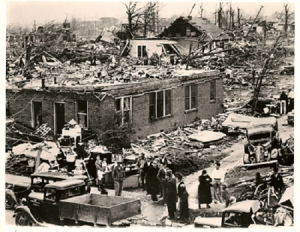 victims. The majority of the bodies were found in Gum Pond, the area which is now Gumtree Park, but many bodies were never recovered from the pond at all. The winds were so strong, that pine needles were embedded into trunks of trees. The tornado took out the large concrete Battle of Tupelo monument as it exited the city’s east side. According to records, the Tupelo tornado leveled 48 city blocks and between 200 and 900 homes. It officially killed at least 216 people and injured at least 700. The tornado destroyed the water tower and produced numerous fires in its wake. Thankfully, overnight rains, which left knee-deep water in some streets put out the fires. Though 216 remained the final death toll, 100 persons were still hospitalized at the time it was set. Subsequently, the Mississippi State Geologist estimated a final, unofficial death toll of 233. Surprisingly, one-year-old Elvis Presley and his parents were among the survivors, a fact I never knew about him.
victims. The majority of the bodies were found in Gum Pond, the area which is now Gumtree Park, but many bodies were never recovered from the pond at all. The winds were so strong, that pine needles were embedded into trunks of trees. The tornado took out the large concrete Battle of Tupelo monument as it exited the city’s east side. According to records, the Tupelo tornado leveled 48 city blocks and between 200 and 900 homes. It officially killed at least 216 people and injured at least 700. The tornado destroyed the water tower and produced numerous fires in its wake. Thankfully, overnight rains, which left knee-deep water in some streets put out the fires. Though 216 remained the final death toll, 100 persons were still hospitalized at the time it was set. Subsequently, the Mississippi State Geologist estimated a final, unofficial death toll of 233. Surprisingly, one-year-old Elvis Presley and his parents were among the survivors, a fact I never knew about him.
After ravaging Tupelo, the storm system moved through Alabama overnight and reached Gainesville, Georgia, at around 8:30am. When the storm hit Gainesville, it became a double tornado event. One tornado moved in from the Atlanta highway, while the other moved in from the Dawsonville highway. As they came into town, the two tornadoes then merged into one on Grove Street and destroyed everything throughout the downtown area…leaving 10 foot high piles of debris in some places. The worst tornado-caused death toll in a single building in United States history was at the Cooper Pants Factory. The multiple-story building was then filled with young workers, who had just arrived to work. The structure collapsed and caught fire, killing about 70 people. At the Pacolet Mill, 550 workers moved to the northeast side of the building and survived. Many people sought refuge in Newman’s department store, and its collapse killed 20 people. In addition to the complete destruction that occurred throughout downtown Gainesville, residential areas throughout the city were 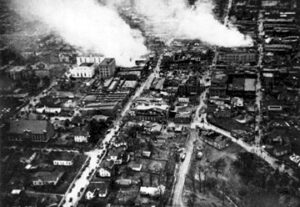 devastated as well, where 750 homes were destroyed, and 254 others were badly damaged.
devastated as well, where 750 homes were destroyed, and 254 others were badly damaged.
The Tupelo-Gainesville Outbreak took the lives of 454 people, 419 by the two main two tornadoes alone. This outbreak is the second deadliest ever recorded in United States history. Although the outbreak was centered on Tupelo, Mississippi, and Gainesville, Georgia, where the fourth and fifth deadliest tornadoes in United States history respectively occurred, other destructive tornadoes associated with the outbreak hit Columbia, Tennessee; Anderson, South Carolina; and Acworth, Georgia.
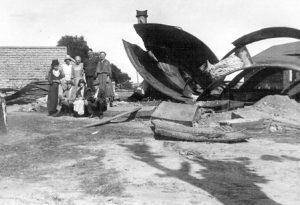
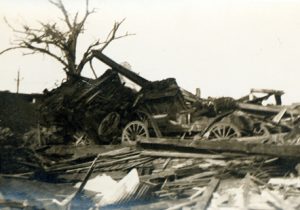 Over the centuries, tornadoes have managed to wreak havoc on various areas of the world, not to mention the thousands of lives they have taken. With advancements in the early warning systems and on weather conditions, the deaths have decreased, but in 1920, no such systems existed. It was March 28, 1920…Palm Sunday, when at least 37 tornadoes, 31 of which were significant, raged across the Midwest and Deep South states. The tornadoes left more than 380 dead, as well as at least 1,215 injured. Many communities and outlying farmers alike were caught off guard as the storms moved to the northeast at speeds that reached over 60 miles per hour. Georgia saw most of the fatalities with over 200 deaths. Indiana had 56 deaths and Ohio had 55, while the other states saw fewer fatalities. Without ways to monitor the tornadoes, very little is known about many of the specific tornadoes that occurred.
Over the centuries, tornadoes have managed to wreak havoc on various areas of the world, not to mention the thousands of lives they have taken. With advancements in the early warning systems and on weather conditions, the deaths have decreased, but in 1920, no such systems existed. It was March 28, 1920…Palm Sunday, when at least 37 tornadoes, 31 of which were significant, raged across the Midwest and Deep South states. The tornadoes left more than 380 dead, as well as at least 1,215 injured. Many communities and outlying farmers alike were caught off guard as the storms moved to the northeast at speeds that reached over 60 miles per hour. Georgia saw most of the fatalities with over 200 deaths. Indiana had 56 deaths and Ohio had 55, while the other states saw fewer fatalities. Without ways to monitor the tornadoes, very little is known about many of the specific tornadoes that occurred.
Early in the morning of March 28th, severe thunderstorms began developing in Missouri, moving quickly to the northeast towards Chicago, Illinois. The first tornado injured five people 35 miles southeast of Springfield, Missouri, in Douglas County. This first tornado was a warning of things to come as the morning went on and the atmosphere began to destabilize, due to the abundance of sunshine that preceded the cold front in the warm sector, which covered the lower Great Lakes region extending southward, well past the Ohio River Valley. According to meteorologist and weather historian Charles Merlin Umpenhour, the climatic conditions on Palm Sunday 1920 were favorable for all the atmospheric ingredients to come together that were needed to create the classic setup for long-track tornadoes. The forecasting…or communications technology and public awareness about Severe Weather was nearly nonexistent in 1920. That technology would not begin for another 33 years, when the US Weather Bureau implemented its Public Watch.
The residents of the Great Lakes region and Ohio Valley areas, had as their only source of weather information, the rather vague forecasts that were issued in the local newspaper the day before or by word of mouth. The use of the word “tornado” was strictly prohibited in public weather forecasting until the 1950s because of the fear and panic it might cause. This policy would come under fire in the years to come especially after the Tri-State Tornado in 1925 that stands today as the deadliest tornado in American history…as it should have. It would be insane not to let the people know of such deadly weather, simply because someone might get scared. That really is the point of it. To “scare” people into action!! It saves lives.
Weather forecasters and the public alike in the Chicago, Dayton, Fort Wayne, Lansing, South Bend, and Toledo areas were unaware of the likelihood of a significant tornado outbreak that would follow a beautiful Palm Sunday afternoon. The weather maps in use in March 1920 showed a rather large and deep cyclone over northern Iowa, and they knew it would be moving across central Lower Michigan by nightfall with a cold front right behind it. Meteorologists knew rain showers, and very likely thundershowers, were a good possibility, but were unaware that the helicity (which is a property of a moving fluid which represents the potential for helical flow…or a flow which follows the pattern of a corkscrew to evolve. Helicity is proportional to the strength of the 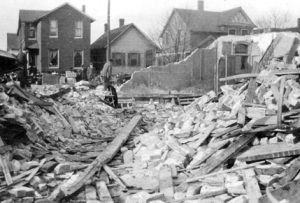
 flow, the amount of vertical wind shear, and the amount of turning in the flow known as a vorticity), the lifted index, and upper level winds which were being guided by a strong jet stream with a probable negative tilt. When all that is put together, it creates conditions that are favorable for the development of tornadoes, and thereby, a seriously dangerous situation. Had the people known all that in 1920, perhaps most of the lives lost, could have been saved.
flow, the amount of vertical wind shear, and the amount of turning in the flow known as a vorticity), the lifted index, and upper level winds which were being guided by a strong jet stream with a probable negative tilt. When all that is put together, it creates conditions that are favorable for the development of tornadoes, and thereby, a seriously dangerous situation. Had the people known all that in 1920, perhaps most of the lives lost, could have been saved.
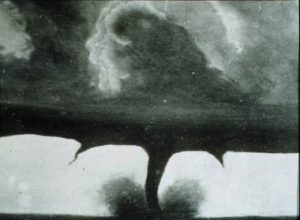 These days, tornado watches and warnings are a normal part of life. They may not happen every day, but when they do sound, we know what to do to stay as safe as possible. The warnings don’t always mean that there are zero deaths from a tornado, but they do help. Unfortunately, the tornado warning sirens, Doppler radar, and television warnings did not exist in 1884. In those days, people had to rely on the skies to tell them what was coming, and as most of us know, that is not always an easy task. In fact, it has taken hundreds of years to even begin to come close to perfecting a system whereby the public could be warned of approaching severe weather, and even then, it hasn’t eliminated the deaths that can occur from these storms.
These days, tornado watches and warnings are a normal part of life. They may not happen every day, but when they do sound, we know what to do to stay as safe as possible. The warnings don’t always mean that there are zero deaths from a tornado, but they do help. Unfortunately, the tornado warning sirens, Doppler radar, and television warnings did not exist in 1884. In those days, people had to rely on the skies to tell them what was coming, and as most of us know, that is not always an easy task. In fact, it has taken hundreds of years to even begin to come close to perfecting a system whereby the public could be warned of approaching severe weather, and even then, it hasn’t eliminated the deaths that can occur from these storms.
One of the largest and most widespread tornado outbreaks in American history happened at a time when warnings did not exist. It happened on this day February 19, 1884, and into February 20, 1884. The precise number of tornadoes, as well as fatalities incurred during the outbreak remains unknown. The outbreak was nicknamed “Enigma outbreak” and is well known by that name. Research of newspaper reports and governmental studies published in the aftermath reveals tornadoes, or in reality, long-track tornado families, struck Alabama, 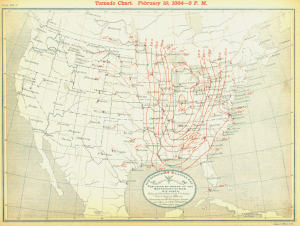 Georgia, Illinois, Indiana, Kentucky, Mississippi, North Carolina, South Carolina, Tennessee and Virginia. It is estimated that at least 50 tornadoes struck those states that day. Some events that had been counted as tornadoes in initial studies, such as those by John Park Finley, were actually downbursts, especially in northern and northeastern portions of the outbreak. Nevertheless, the damage done was nothing to be overlooked.
Georgia, Illinois, Indiana, Kentucky, Mississippi, North Carolina, South Carolina, Tennessee and Virginia. It is estimated that at least 50 tornadoes struck those states that day. Some events that had been counted as tornadoes in initial studies, such as those by John Park Finley, were actually downbursts, especially in northern and northeastern portions of the outbreak. Nevertheless, the damage done was nothing to be overlooked.
The majority of the reported tornadic activity was seen across Alabama, Georgia, South Carolina and North Carolina, which were all struck severely by multiple waves of tornado families. In the Southeast, the outbreak began during the late morning in Mississippi, preceded by severe thunderstorms in Louisiana. Shortly thereafter, the outbreak widened and intensified, progressing from Alabama to Virginia between noon and midnight. In addition to the outbreak, wind damage, flash floods, with homes swept away by water in Louisville, Kentucky, New Albany, Indiana, and Jeffersonville, Indiana and other towns along the Ohio River, and Derecho-like effects in the Ohio Valley were also reported in published accounts of the outbreak. In case you didn’t know, a Derecho is a widespread, long-lived, straight-line wind storm that is 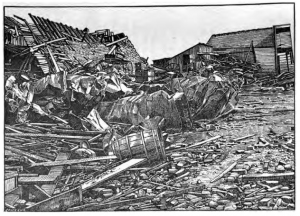 associated with a land-based, fast-moving group of severe thunderstorms. In addition to that, blizzard conditions occurred in the eastern Midwest, as a part of this storm series. According to an article appearing in the Statesville, North Carolina Landmark three days later, the damage tally in Georgia alone was estimated to be $1 million, in 1884 dollars. Today, the damage would have been approximately $23,660,667. That is an astounding figure, and that is just the property damage numbers. Loss of life simply cannot be measured in money. In fact, the greatest mystery surrounding this horrific event is the possibility that, in all likelihood, as many as 1,200 people lost their lives that day at the hands of the 1884 Enigma Tornado Outbreak.
associated with a land-based, fast-moving group of severe thunderstorms. In addition to that, blizzard conditions occurred in the eastern Midwest, as a part of this storm series. According to an article appearing in the Statesville, North Carolina Landmark three days later, the damage tally in Georgia alone was estimated to be $1 million, in 1884 dollars. Today, the damage would have been approximately $23,660,667. That is an astounding figure, and that is just the property damage numbers. Loss of life simply cannot be measured in money. In fact, the greatest mystery surrounding this horrific event is the possibility that, in all likelihood, as many as 1,200 people lost their lives that day at the hands of the 1884 Enigma Tornado Outbreak.

